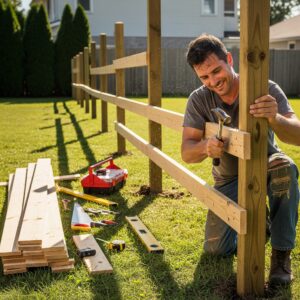TL;DR
If your iron gate has minor issues like squeaky hinges or surface rust, a repair may be all you need. But if the structure is warped, rust is deep, or automation keeps failing, replacement is often the smarter long-term investment. This guide helps you make the right call — with real signs, costs, and tips.
Introduction – When an Iron Gate Starts to Fail
Iron gates are built to last — but even the strongest ones wear down over time. Maybe yours isn’t closing like it used to. Maybe it leans a little more after every storm. Or maybe the paint’s bubbling, and the rust underneath is starting to show.
At that point, the question hits: should I fix it, or is it time to replace it?
This blog will help you answer that. We’ll walk through what issues can be repaired easily (and affordably), which ones are signs of deeper failure, and how to weigh the cost difference — including when it makes sense to start fresh.
Because replacing a gate isn’t just about function — it’s about safety, curb appeal, and peace of mind.
Section 1: Signs It’s Time to Repair, Not Replace
Not every crack, squeak, or chip means you need a whole new gate. In fact, many issues are cosmetic or minor mechanical problems that can be fixed quickly — and for less money than you might think.
Common signs your gate is a good candidate for repair:
-
Hinges squeaking or loose but the structure is stable
-
Paint bubbling or chipping, especially near joints or the base
-
Gate slightly misaligned after winter storms or soil movement
-
Manual gate working fine, but automation isn’t syncing
-
No major rust-through — just surface spots or small patches
Here’s a quick breakdown of typical repairs and cost ranges:
| Repair Type | Average Cost | Notes |
|---|---|---|
| Repainting surface rust | $300–$600 | Depends on gate size + prep |
| Hinge tightening or replacement | $150–$400 | Can extend gate life years |
| Minor alignment adjustment | $200–$500 | Especially after soil shift |
| Automation sensor fix | $250–$600 | Motor OK, signal or sensor off |
| Gate post re-stabilization | $500–$900 | Cheaper than full replacement |
If you catch these problems early, you’re not just saving money — you’re protecting your long-term investment. In many cases, homeowners wait too long and end up replacing a gate that could have lasted another decade with a little maintenance.
Section 2: Signs You Should Replace It Entirely
Sometimes, repairs are like putting a patch on a sinking boat. If your iron gate has deeper issues — structural, aesthetic, or functional — replacement may be the smarter, safer option.
Here are the most common signs it’s time to start fresh:
1. Major Structural Damage
If your gate leans heavily, scrapes the ground constantly, or the posts have shifted significantly, there’s likely foundational damage. This is especially common in areas with expanding soils or long-term water exposure.
2. Deep Rust or Full Metal Deterioration
When rust isn’t just on the surface but has eaten through the iron or created flakes and holes, it’s no longer just cosmetic. Deep rust weakens the frame and makes the gate unsafe — especially under weight or wind.
3. Repeated Repairs That Don’t Last
If you’ve already repaired hinges, repainted, re-aligned, or replaced the motor multiple times in the past few years, you’re dealing with a system that’s past its prime. The more you spend trying to “fix” it, the more cost-effective a replacement becomes.
4. Mismatched Appearance
If the gate no longer matches your fence, the rest of your home’s exterior, or your property’s layout (for example, after adding a new driveway or landscaping), it may feel out of place — and buyers will notice.
5. Outdated or Incompatible Automation
Some older iron gates were retrofitted with automation that’s now unreliable, glitchy, or simply not compatible with today’s smart systems. If repairs require outdated parts or discontinued tech, it’s time for a system that will last another 10–20 years.
For a deeper dive into early gate failure signs — and what causes them — check out The Silent Death of Your Metal Gate, one of our most-read articles on the topic.
In the next section, we’ll lay out real repair vs. replacement cost
Section 3: Repair vs Replace – Cost Comparison
If you’re stuck between repairing your gate again or investing in a new one, cost is likely a key factor. But it’s not just about price today — it’s about what saves you money (and stress) over the next 5 to 10 years.
Here’s how repair and replacement stack up:
Typical Repair Costs
| Issue | Average Cost |
|---|---|
| Surface rust removal & repainting | $300 – $600 |
| Hinge or latch replacement | $150 – $400 |
| Realignment or minor welding | $250 – $600 |
| Automation sensor or remote issues | $250 – $750 |
| Gate post stabilization | $500 – $900 |
These costs can keep your gate going strong if the structure is still sound. But repairs can add up quickly if you’re doing them every year or two.
Typical Replacement Costs
| Gate Type | Average Installed Cost |
|---|---|
| Standard manual iron gate | $2,500 – $4,500 |
| Automatic driveway gate (swinging) | $5,500 – $7,500 |
| Sliding automatic gate (modern) | $6,500 – $9,000+ |
This includes removal of the old gate, new post setting, welding, painting or powder coating, and new hardware.
While it’s a larger upfront cost, replacing a failing gate may save you from constant patchwork, repairs, and malfunctions — especially with automation involved.
Section 4: How to Extend the Life of Your Gate (If You Keep It)
If you’ve decided your iron gate still has life left in it, the next step is making sure it actually lasts — without recurring issues or costly future repairs. Proper maintenance is simple, but it’s often overlooked until things break down.
Here’s how to keep your gate in good shape:
1. Clean It Seasonally
Use a mild soap and water mix to remove dirt, pollen, and buildup — especially around joints and hinges. Rinse well and let it fully dry. This prevents corrosion and keeps rust from forming in crevices.
2. Watch for Paint Flakes or Bubbles
Paint isn’t just for looks — it’s the gate’s first defense against moisture. If you see any bubbles or chipping, lightly sand the area, apply rust inhibitor, and repaint with an outdoor-grade coating.
3. Lubricate Hinges and Latches
At least twice a year, apply a silicone or lithium-based lubricant to all moving parts. This reduces friction, prevents squeaking, and makes opening and closing smoother — especially for automatic gates.
4. Protect Automation Equipment
For gates with motors or access panels, check for water exposure, nesting insects, and loose wiring. Enclose exposed elements, and clean off any debris to prevent malfunctions.
5. Check Ground Level and Drainage
If your gate posts are sinking or shifting, it’s often due to water buildup or poor grading. Make sure the area around the gate drains properly. Adding a gravel base or adjusting the slope can prevent further issues.
Expert Tip: A professional inspection every few years can spot issues you might miss. At Irish Iron, we’ve helped dozens of Sacramento-area homeowners add 10+ years to their gate’s lifespan with just a few smart tweaks.
Section 5: Don’t Guess — Get a Professional Evaluation
Even if your gate seems fine from a distance, small issues can turn into big (and expensive) problems fast — especially in older homes or high-traffic properties.
A quick professional inspection can give you clarity:
-
What’s cosmetic vs. structural
-
What can be fixed easily vs. what’s nearing failure
-
What updates might actually raise your property value
Many homeowners assume replacement is the only option when something breaks. But in reality, the solution might be a $300 repair, not a $5,000 overhaul — and knowing the difference matters.
Irish Iron offers free consultations across the Sacramento region, and we’ve built and repaired everything from historic wrought iron gates to modern smart-entry systems. We’ll give you honest advice — whether it’s time to repair, replace, or just do a tune-up. If you’re hiring a contractor, make sure they follow best practices like those recommended by the American Fence Association — including proper post setup, drainage planning, and hardware installation.
But for anything structural, electrical, or rust-related — don’t take chances. A five-minute fix can become a five-week problem if left too long.
Frequently Asked Questions
Can I repaint a rusted iron gate myself?
Yes, if the rust is only surface-level. Sand the area, apply a rust converter or primer, and use outdoor metal paint.
Is it worth repairing an old automatic gate system?
Sometimes — but only if parts are still available and the motor hasn’t degraded. If the system is glitching often, a modern upgrade may be more cost-effective.
How long should an iron gate last?
With proper maintenance, 20–30 years or more. Regular cleaning and repainting can significantly extend lifespan.
Will replacing my gate boost home value?
It can — especially if the gate improves curb appeal, matches updated fencing, or adds automation features.
Need help deciding what’s right for your gate?
Contact Irish Iron today for a quick, honest evaluation. We’ll help you protect your investment — and make your entryway something you’re proud of.



